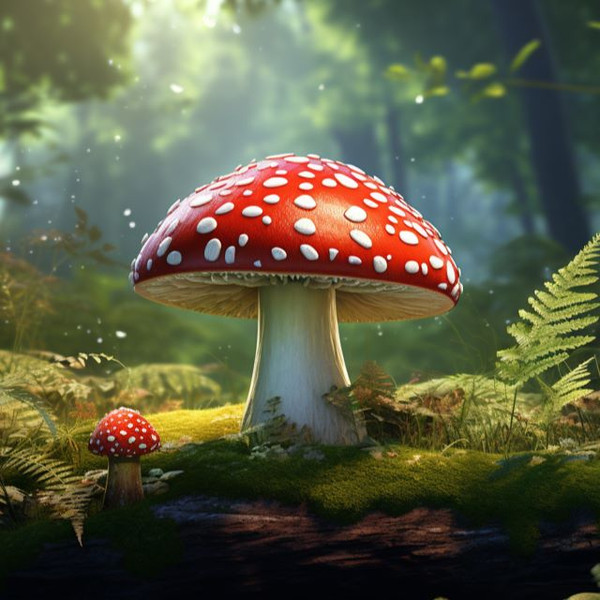Amanita Muscaria Mushroom | Fly Agaric Mushrooms | Christmas Traditions Explained
Posted by Troy Cosky, Founder FunGuy Grow Supply on 9th Dec 2023
![]()
Exploring Christmas Traditions of Amanita Muscaria Mushroom and Fly Agaric Mushrooms
Have you ever wondered about the mysterious connection between Amanita Muscaria and Christmas traditions? In this article, we will delve into the fascinating historical use and cultural significance of this iconic mushroom in various holiday customs. By exploring its symbolism and debunking misconceptions, we aim to shed light on the intriguing role Amanita Muscaria plays in our festive celebrations. Get ready to uncover the truth behind this enchanting Christmas tradition.
Key Takeaways
- The red and white appearance of Amanita Muscaria resembles the colors associated with Santa Claus.
- The mushroom's association with altered states of consciousness aligns with the themes of transcendence and mystical experiences often associated with the holiday season.
- Some theories suggest that Amanita Muscaria may have influenced the concept of Santa Claus.
- Its presence in Christmas traditions is multifaceted and varies across different cultures.
What is Amanita Muscaria?
Amanita Muscaria is a mushroom known for its distinctive appearance and hallucinogenic properties. Native to Siberian forests in Eurasia, this mushroom belongs to the family Amanitaceae. Its bright red cap, covered in white scales or dots, is a sight to behold. But what sets Amanita Muscaria apart is not just its visual appeal; it also possesses unique pigments called betalains, responsible for its vibrant coloring. Surprisingly, betalains were previously thought to be absent in fungi until recent studies revealed their presence in Amanita Muscaria.
![]()
The cap of Amanita Muscaria is adorned with white flecks, creating a surreal and captivating aesthetic. These flecks are often more densely distributed towards the center of the cap, adding to its allure. It's no wonder that this mushroom has captured the imagination of many, even beyond its hallucinogenic properties.
Speaking of its hallucinogenic properties, Amanita Muscaria has been used for centuries by different cultures for various purposes. In some cultures, it has been used in religious and spiritual ceremonies, where it is believed to induce visions and altered states of consciousness. Interestingly, Amanita Muscaria has also been associated with Christmas traditions in certain parts of the world. Its vibrant red and white colors resemble the iconic imagery of Santa Claus, and some theories suggest that it may have influenced the concept of the jolly old man in a red suit.
In addition to its cultural significance, Amanita Muscaria has also been studied for its potential medicinal uses. Compounds found in this mushroom have shown promise in areas such as pain management, neuroprotection, and even cancer treatment. However, further research is needed to fully understand its therapeutic potential.
Historical Use in Shamanic Rituals and Folklore
Throughout history, shamanic cultures have frequently incorporated Amanita muscaria into their rituals and folklore, often consuming the mushroom to access altered states of consciousness and commune with the spiritual realm. This mushroom, known for its psychoactive properties, has been used by indigenous peoples across Eurasia for centuries. In Siberian shamanism, Amanita muscaria was believed to allow shamans to communicate with spirits and enter into altered states of consciousness. Similarly, in Nordic mythology, this mushroom was associated with divine origins and was believed to have been created from Odin's beard hair, symbolizing its mystical and otherworldly nature.
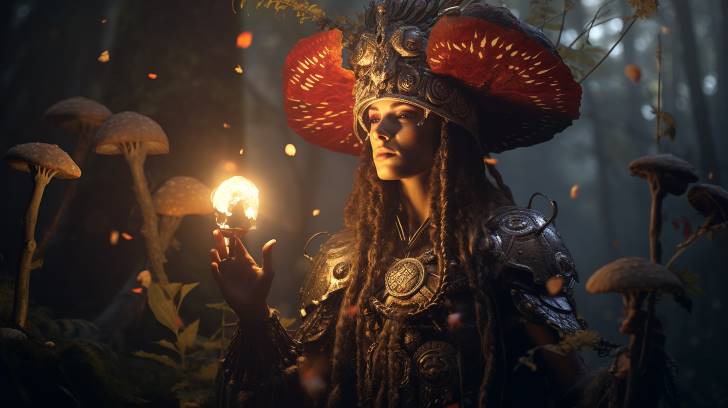
To further explore the historical use of Amanita muscaria in shamanic rituals and folklore, let's take a closer look at its effects, uses, and benefits:
| Effects, Uses, and Benefits | Information |
|---|---|
| Is Amanita muscaria legal? | The legal status of Amanita muscaria varies across countries and regions. In some places, it is legal to possess and consume, while in others, it may be regulated or prohibited. It is important to research and understand the legal implications of using Amanita muscaria in your specific location. |
| Amanita muscaria effects | Consumption of Amanita muscaria can induce various effects, including hallucinations, altered perception of time and space, increased sensory awareness, and feelings of euphoria. However, it is crucial to note that the effects can vary depending on the individual, dosage, and preparation method. It is recommended to approach Amanita muscaria with caution and under the guidance of experienced practitioners. |
| What is Amanita muscaria used for? | Amanita muscaria has been used for its psychoactive properties in shamanic rituals, spiritual practices, and traditional ceremonies. It is believed to facilitate communication with the spiritual realm, provide insights, and aid in healing processes. Additionally, it has been used in some cultures as a tool for divination and prophecy. |
| Amanita muscaria benefits | The benefits associated with the use of Amanita muscaria are primarily subjective and deeply rooted in cultural and spiritual beliefs. Some practitioners believe that it can enhance spiritual experiences, promote self-discovery, and foster a deeper connection with nature and the divine. However, it is essential to approach its use with respect, caution, and proper knowledge to minimize potential risks. |
| Amanita muscaria mushrooms Christmas | The connection between Amanita muscaria and Christmas traditions is multifaceted. In some cultures, the red and white appearance of the mushroom resembles the colors associated with Santa Claus. Additionally, the mushroom's association with altered states of consciousness and spiritual connection aligns with the themes of transcendence and mystical experiences often associated with the holiday season. |
Cultural Significance of Amanita Muscaria Beyond Christmas Traditions
While Amanita muscaria's association with Christmas traditions is well-known, its cultural significance extends far beyond the holiday season. This unique mushroom has been incorporated into various customs and beliefs across different cultures, revealing a deeper meaning and importance.
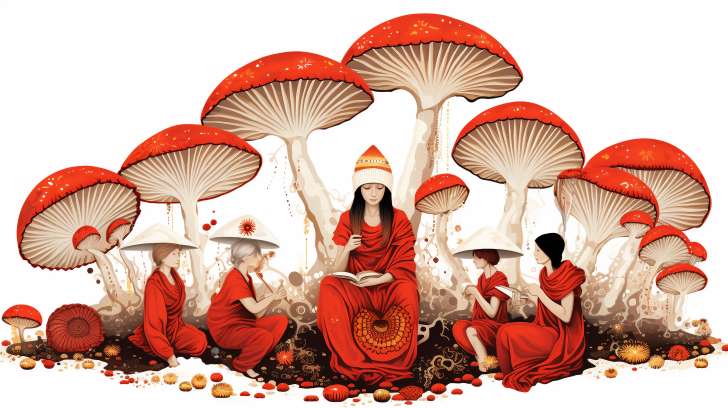
Here are five examples of the cultural significance of Amanita muscaria beyond Christmas traditions:
- Shamanistic Practices: The Sami people of northern Scandinavia have used Amanita muscaria mushrooms as a part of their shamanistic rituals. They believe that these mushrooms can help them connect with the spirit world and gain supernatural powers. This highlights the mushroom's role in spiritual and mystical experiences.
- Traditional Chinese Medicine: In China, Amanita muscaria mushrooms are referred to as 'red and white mushrooms' or 'immortality mushrooms'. They have been used for centuries in traditional Chinese medicine to treat various health conditions such as coughs, fever, and asthma. This demonstrates the mushroom's medicinal properties and its integration into ancient healing practices.
- Indigenous Ceremonies: The indigenous tribes of North America, from Alaska down to Mexico, have also incorporated Amanita muscaria mushrooms into their sacred ceremonies. For example, the Shoshone believed that consuming these mushrooms in sweat lodges allowed them to receive visions. This showcases the mushroom's role in spiritual rituals and cultural traditions.
- Artistic Depictions: Some Native American cultures have showcased the importance of Amanita muscaria mushrooms through their artwork. They painted motifs featuring fly agaric mushrooms and incorporated narratives about their cultural significance. This signifies the mushroom's influence on artistic expression and storytelling within indigenous communities.
- Symbolism and Folklore: Amanita muscaria mushrooms have also become symbols in folklore and mythology. They are often associated with magical and transformative properties, representing a bridge between the natural and supernatural realms. This symbolizes humanity's fascination with the mysterious and unknown.
Symbolism of Amanita Muscaria in Christmas
You frequently encounter the symbolic presence of Amanita muscaria in Christmas traditions. This iconic mushroom has been associated with various elements of the holiday, including the popular image of Santa Claus. One theory suggests that Santa's red and white suit is reminiscent of the mushroom's vibrant red cap and white spots. This connection between Santa and Amanita muscaria goes even deeper. It is believed that shamans, who would dress up as Santa Claus, would travel from house to house delivering gifts that contained hallucinogenic mushrooms, such as Amanita muscaria. They would use sleds or sleighs made from bark or bark-like materials, pulled by reindeer. This may be related to the Nordic folklore about flying deer, which were said to have consumed these magic mushrooms and gained the ability to fly through the sky.
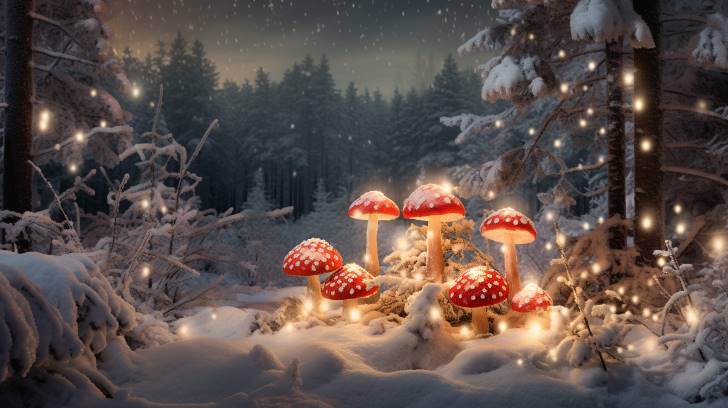
Furthermore, Amanita muscaria has become a popular symbol in Christmas decorations. Many holiday ornaments feature images of this mushroom. However, it is essential to note that the incorporation of Amanita muscaria into festive items does not necessarily endorse its consumption. In fact, there are myths surrounding the toxicity of this mushroom, raising questions about its suitability for consumption.
Additionally, the tradition of bringing evergreen trees inside during wintertime may have roots in pagan beliefs. It is believed that people living in areas where Amanita muscaria grew would decorate their trees with strings made from dried mushroom caps. These decorations were inspired by visions experienced during altered states induced by consuming the mushrooms. This practice was seen as a way to connect with the spirits of nature when the boundary between worlds was believed to be thin.
Controversy and Misconceptions Surrounding Amanita Muscaria
Many people hold misconceptions and controversy surrounding the consumption of Amanita muscaria, a mushroom known for its connection to Christmas traditions. It is important to address these concerns and clarify the facts to provide a comprehensive understanding of this mushroom and its psychedelic effects.
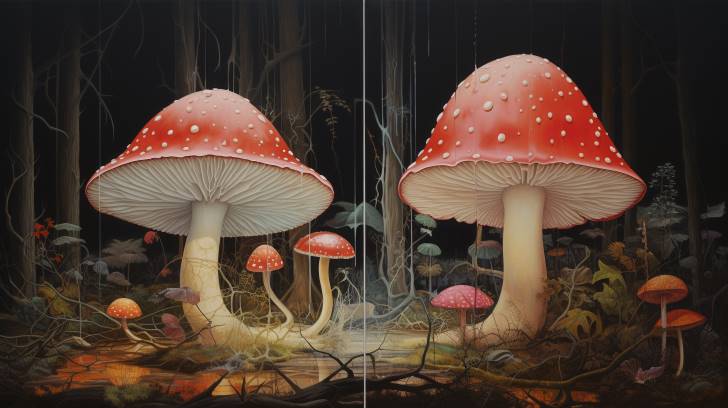
Here are some key points to consider:
- Toxicity: There are a lot of toxins in these mushrooms such as ibotenic acid and muscimol, which can be highly lethal if consumed in large amounts. Symptoms of mushroom poisoning include nausea, vomiting, confusion, seizures, and coma. It is crucial to recognize the dangers associated with this mushroom and exercise caution.
- Proper Dosage: The psychoactive compounds in Amanita muscaria are notoriously difficult to dose accurately. Consuming it too much can lead to severe cases of mushroom poisoning. It is essential to understand the appropriate dosage and seek guidance from reputable sources or professionals experienced in working with this mushroom.
- Rare Cases of Toxicity: While serious toxicity from Amanita muscaria can occur, it is relatively rare compared to other toxic mushrooms such as the deadly amanitas or death cap mushroom. This may be attributed to the accumulated knowledge and experience of traditional shamans who have used Amanita muscaria over centuries.
- Lack of Clear Information: Controversy surrounding Amanita muscaria is often fueled by a lack of clear information and access to reliable resources. Proper usage of this mushroom requires accurate information and understanding of its effects. Accessing reputable sources and seeking professional guidance can help mitigate misconceptions and ensure safe consumption.
- Individual Sensitivities: It is important to note that people may have varying sensitivities to Amanita muscaria. What may be a mild experience for one person could be overwhelming for another. Understanding individual sensitivities and respecting personal boundaries is crucial when considering the consumption of this mushroom.
In light of the controversy and misconceptions surrounding Amanita muscaria, it is essential to explore its legal status to gain a complete understanding of its use and potential consequences.
The Legal Status of Amanita Muscaria; A fly Agaric Mushroom
The legality of Amanita muscaria mushrooms varies depending on the jurisdiction and regulations surrounding their possession and distribution.
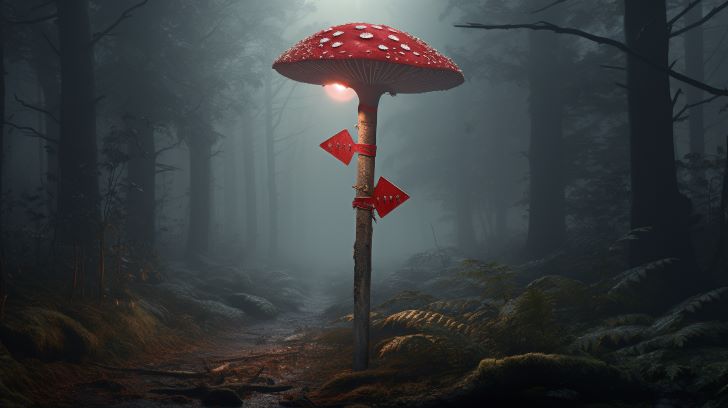
Here is a breakdown of the legal status of Amanita muscaria mushrooms in different countries:
| Country | Legal Status |
|---|---|
| Canada | Possession is not considered a criminal offense. |
| Distribution may require proper permits. | |
| United States | Possession is not considered a criminal offense. |
| Distribution may require proper permits. | |
| Japan | Both possession and distribution are illegal. |
| Sweden | Both possession and distribution are illegal. |
It's important to note that the legal status may vary within different states in the United States. Some states have fully legalized psilocybin groups containing mushrooms as part of therapy sessions. Therefore, it is crucial to research and understand the specific regulations governing the possession and distribution of Amanita muscaria mushrooms in your particular location.
While the legal status of Amanita muscaria mushrooms is an important consideration, it is equally vital to be aware of the potential risks and rewards associated with their use. Understanding the potential dangers and benefits will help you make informed decisions regarding the consumption and cultivation of these mushrooms.
The dangers and benefits of using Amanita Muscaria
Exploring the potential dangers and benefits of Amanita muscaria use is essential for understanding its risks and rewards. When considering the risks, it's important to note that Amanita muscaria contains toxins that can be extremely dangerous when consumed improperly, potentially leading to severe poisoning and even death. The psychoactive compounds in the mushroom are notoriously difficult to dose accurately, which further increases the risk of these poisonous mushrooms. Additionally, the legality of Amanita muscaria varies from country to country and even within individual countries, so understanding the laws governing the mushroom in your specific location is crucial before taking any action.

On the other hand, there are potential rewards associated with Amanita muscaria use. It has a rich history of use in spiritual and cultural contexts, suggesting that it holds some value for those who partake in its consumption. Some individuals have reported beneficial effects from consuming Amanita muscaria, including increased creativity, enhanced spiritual experiences, and improved mood. Furthermore, properly dosed Amanita muscaria may have therapeutic potential for certain conditions, although more research is needed to fully understand its benefits and risks.
Conclusion
To conclude, it is essential for you to recognize the potential risks and benefits associated with Amanita muscaria's use, as well as the importance of informed decision-making when it comes to engaging with this mushroom. Amanita muscaria holds a rich history intertwined with cultural and mythical associations, particularly during Christmas traditions. While it may be tempting to explore its potential effects, it is crucial to approach its use with caution.
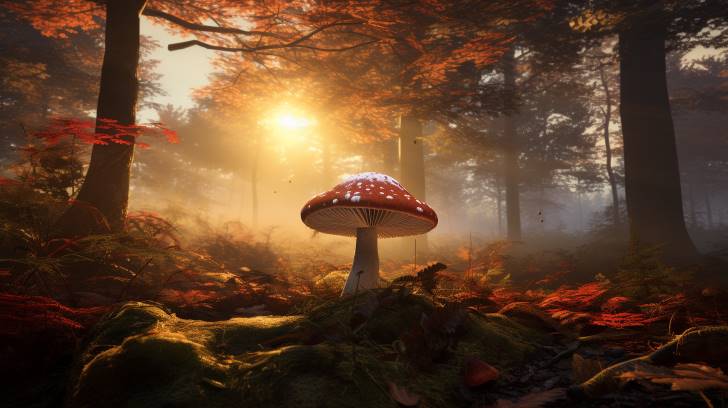
First and foremost, it is important to acknowledge the potential risks associated with Amanita muscaria. This mushroom contains psychoactive compounds such as muscimol and ibotenic acid, which can cause hallucinations and other mind-altering effects. However, these effects can vary greatly depending on factors such as dosage, individual tolerance, and preparation methods. It is crucial to understand that improper use or ingestion of this mushroom can lead to adverse reactions, including nausea, dizziness, and in some cases, even poisoning.
On the other hand, there may be potential benefits to engaging with Amanita muscaria, particularly in the context of shamanic rituals and spiritual practices. Some individuals believe that this mushroom can facilitate introspection, spiritual experiences, and personal growth. However, it is important to note that these potential benefits are largely based on anecdotal evidence, and scientific research on the therapeutic effects of Amanita muscaria is limited.
Informed decision-making is key when it comes to engaging with Amanita muscaria. It is crucial to research and understand the potential risks and benefits associated with its use. If you choose to engage with this mushroom, it is important to ensure that you are obtaining it from a reputable source and that you are following safe dosage guidelines. Additionally, it is advisable to consult with a healthcare professional before experimenting with Amanita muscaria, especially if you have any underlying health conditions or are taking medication.
Ready To Start Growing Mushrooms
Visit FunGuy Grow Supply for the best selection of mushroom grow bags, kits, and spawn. Shop now and get started on your mushroom growing journey!
Frequently Asked Questions
Can Amanita Muscaria Be Used for Recreational Purposes?
Can you use amanita muscaria for recreational purposes? Well, it's important to note that the use of this mushroom for recreational purposes is not recommended. While it does contain psychoactive compounds, it also has potentially dangerous side effects. Ingesting amanita muscaria can lead to hallucinations, confusion, and even poisoning. It's best to leave the recreational use of this mushroom to the experts and focus on safer alternatives for recreational activities.
What Are the Potential Health Risks Associated With Amanita Muscaria Use?
The potential health risks associated with amanita muscaria use are important to understand. While it is often used for recreational purposes, it is crucial to be aware of the potential dangers. Some of the risks include hallucinations, nausea, vomiting, and confusion. In more severe cases, it can lead to liver damage or even death. It is essential to exercise caution and educate yourself about the potential health risks before using amanita muscaria.
Are There Any Legal Restrictions on the Cultivation or Sale of Amanita Muscaria?
Are there any legal restrictions on the cultivation or sale of Amanita Muscaria? Well, the legality of Amanita Muscaria varies from country to country. In some places, it is completely legal to cultivate and sell this mushroom, while in others, it is regulated or even prohibited. It's important to research and understand the specific laws and regulations in your jurisdiction before engaging in any activities related to Amanita Muscaria. Always prioritize your safety and comply with the laws to avoid any legal issues.
How Does Amanita Muscaria Compare to Other Hallucinogenic Substances in Terms of Its Effects?
When it comes to comparing Amanita Muscaria with other hallucinogenic substances, its effects are unique and distinct. Unlike other substances, Amanita Muscaria can be likened to a gentle dance of colors and emotions, swirling together in harmony. Its hallucinogenic properties create a surreal experience, where reality becomes fluid and perceptions are heightened. However, it's important to note that the effects can vary from person to person, and caution should always be exercised when exploring the world of hallucinogens.
Are There Any Long-Term Effects or Potential Addiction Risks Associated With Amanita Muscaria Use?
When it comes to the long-term effects or potential addiction risks associated with Amanita Muscaria use, it's important to note that research on this specific topic is limited. However, some users have reported experiencing lingering effects such as changes in perception and mood for a period of time after ingestion. As for addiction risks, Amanita Muscaria is not considered to be physically addictive like some other substances. However, it's always crucial to approach any substance with caution and moderation.
Can you eat a fly agaric?
Amanita muscaria, commonly known as the fly agaric mushroom, is toxic and should not be consumed. It contains harmful substances that can cause nausea, vomiting, hallucinations, and even organ failure. Consumption of this mushroom can be life-threatening. It's crucial to avoid ingestion of fly agaric wild mushrooms unless you are absolutely certain they are safe to eat.
References
- Allegro, J. M. (1970). The Sacred Mushroom and The Cross: A study of the nature and origins of Christianity within the fertility cults of the ancient Near East. Gnostic Media Research & Publishing. https://www.semanticscholar.org/paper/The-Sacred-Mushroom-and-The-Cross%3A-A-study-of-the-Allegro/1c972cc93517091533cfede2f6bb154d6eb19ee8
- Wasson, R. G. (1968). Soma: Divine Mushroom of Immortality. New York, NY: Harcourt, Brace & World, Inc.
- Psychedelics Daily: The Ultimate Guide to Amanita Muscaria Mushrooms

